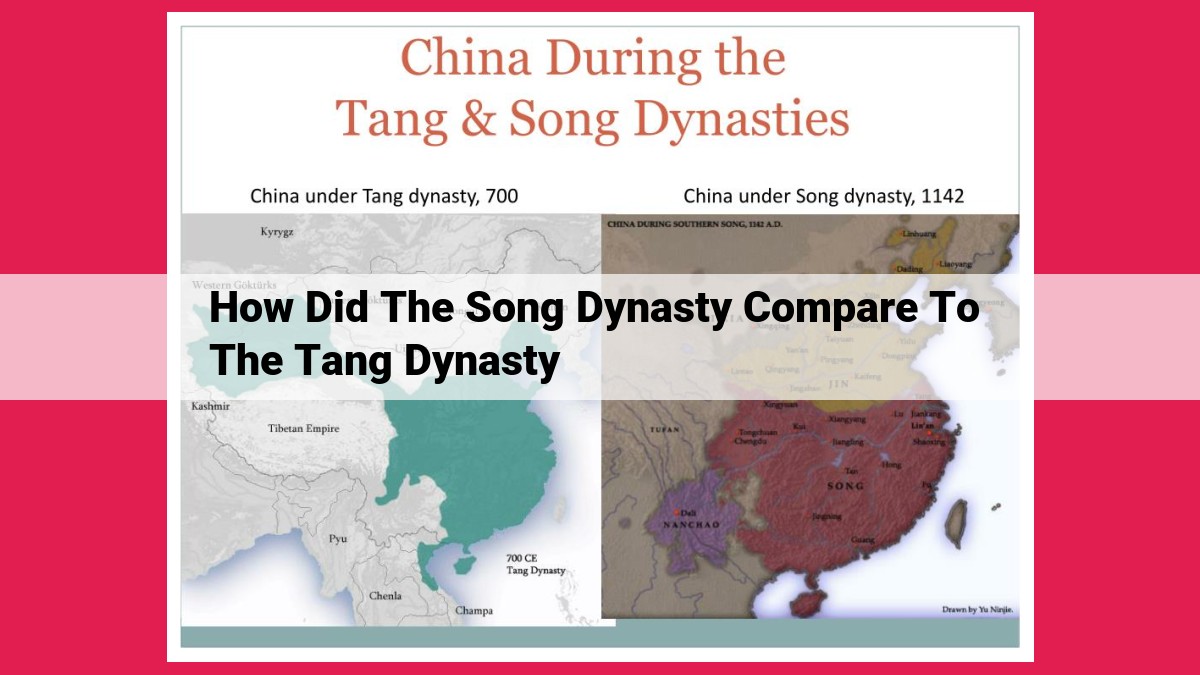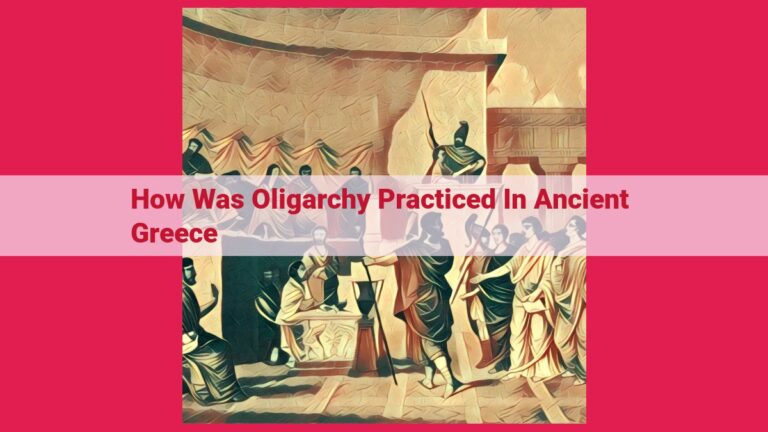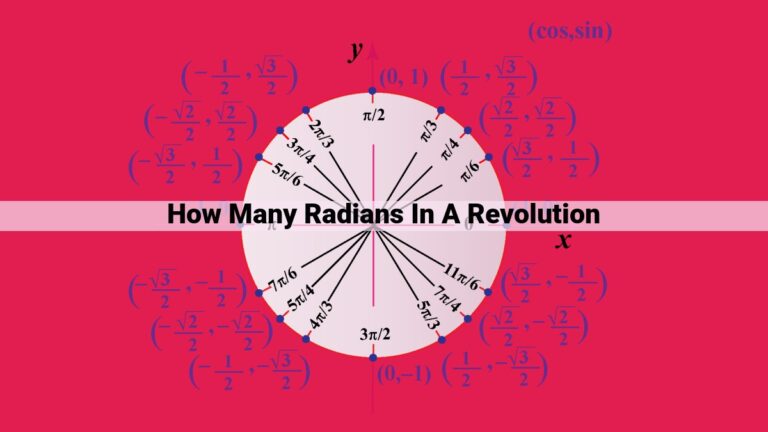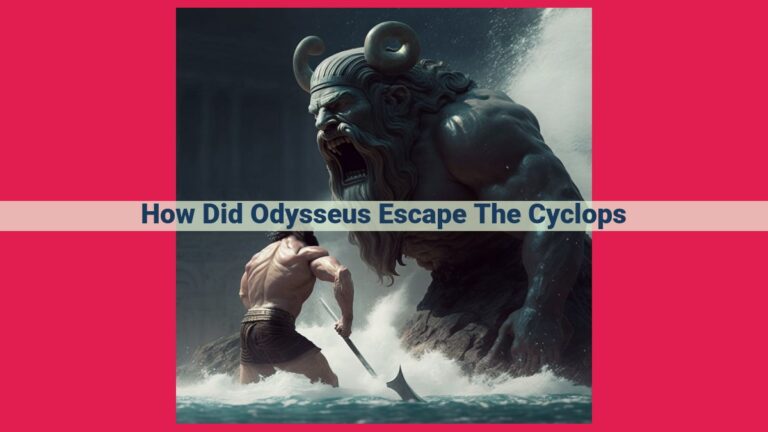Comparing The Song And Tang Dynasties: Political Structure, Economic Prosperity, And Cultural Achievements

The Song Dynasty (960-1279) and Tang Dynasty (618-907) shared similarities in political structure, bureaucratic institutions, and Confucian influence. However, the Song Dynasty experienced greater economic prosperity, trade expansion, and technological advancements. Its civil service system was more meritocratic, while its infrastructure and investment initiatives were more extensive. The Song Dynasty also witnessed a flourishing of cultural achievements, including new literary genres, artistic styles, and philosophical advancements.
Political Structure
- Compare the government structures and administrative systems of the Song and Tang dynasties.
Political Structure: A Tale of Two Dynasties
In the annals of Chinese history, the Song and Tang dynasties stand out as beacons of prosperity, innovation, and cultural achievements. While their differences in timeline span and territorial extent are undeniable, both dynasties shared a profound impact on the nation’s political landscape.
Centralized Governance
Both the Song and Tang dynasties adopted a centralized system of government, with an emperor at its apex. However, there were subtle variations in their administrative structures. The Tang administration featured three departments and six ministries, known as the Three Departments and Six Ministries, which handled essential affairs of the state. The Song, in contrast, introduced the Privy Council, a top-level policy-making body that oversaw various branches of government.
Civil Service System
A defining characteristic of both dynasties was their robust civil service system. Meritocratic principles guided the recruitment and promotion of officials, fostering a bureaucracy that valued competence and loyalty. The Tang dynasty established a comprehensive system of examinations, while the Song expanded it further by including the civil service examinations, which became a cornerstone of Chinese political culture for centuries to come.
Confucian Influence
Confucianism played a pivotal role in shaping the political ideologies of both dynasties. Its emphasis on loyalty, filial piety, and social harmony permeated the governance structures. The examination system favored candidates well-versed in Confucian classics, ensuring that the bureaucracy embraced these values.
Legalism: A Tang Dynamism
While Confucianism set the ideological tone, the Tang dynasty injected a dose of legalism, a philosophy that stressed order, discipline, and strict punishment. This influence was reflected in the establishment of a criminal code, the Tang Code, which streamlined legal procedures and punishments.
Shifts and Refinements: A Story of Evolution
Over time, the political structures of the two dynasties evolved. The Song faced territorial threats from nomadic tribes to the north, leading to a shift towards military meritocracy. The Tang, on the other hand, underwent a transition to a more decentralized system as the dynasty progressed.
Despite their differences, both the Song and Tang dynasties laid the foundation for China’s enduring political legacy. Their centralized governance, civil service systems, and Confucian-influenced ideologies shaped the nation’s political trajectory for centuries to come, leaving an indelible mark on Chinese history and culture.
Governance in the Song and Tang Dynasties: A Comparative Analysis
In the tapestry of Chinese history, the Song and Tang dynasties stand out as beacons of prosperity and innovation. Governance played a pivotal role in shaping these remarkable eras, and a comparative analysis reveals both similarities and striking differences in the bureaucratic institutions and civil service systems that underpinned their political structures.
Bureaucratic Institutions: A Legacy of Centralization
Both the Song and Tang dynasties adopted a centralized bureaucratic system that tied the vast expanse of their empires to the imperial court. At the apex of the administrative hierarchy stood the emperor, who wielded absolute authority and commanded a sprawling network of civil officials. These officials, drawn from the scholar-elite, were responsible for managing every aspect of governance, from collecting taxes to administering justice.
Civil Service Systems: Meritocracy and Examination Culture
The Tang Dynasty:
The Tang Dynasty ushered in a watershed moment in Chinese history with the establishment of a meritocratic civil service system based on rigorous examinations. This system paved the way for talented individuals from all social strata to ascend the ranks of bureaucracy. By emphasizing scholarly merit over familial connections or aristocratic lineage, the Tang Dynasty transformed governance into a profession accessible to all who demonstrated exceptional abilities.
The Song Dynasty:
The Song Dynasty further refined the civil service system by instituting a more comprehensive examination process and establishing a rigorous training curriculum for aspiring bureaucrats. This system elevated meritocracy to new heights, ensuring that the most capable and knowledgeable individuals were entrusted with the reins of power.
Administrative Efficiency and Corruption Control
The centralized bureaucracies of the Song and Tang dynasties sought to streamline administration and minimize corruption. Officials were rotated through different posts to prevent the accumulation of excessive power. Moreover, they were subject to regular audits and held accountable for their actions. These measures helped to ensure that the government machinery ran smoothly and effectively.
The bureaucratic institutions and civil service systems of the Song and Tang dynasties played a crucial role in shaping the political landscape of these remarkable eras. By emphasizing centralized authority, meritocratic recruitment, and administrative efficiency, these systems fostered a governance model that promoted stability, prosperity, and cultural achievements that continue to inspire admiration to this day.
Political Ideologies: The Guiding Forces of the Song and Tang Dynasties
The political landscapes of the Song and Tang dynasties were shaped by a complex interplay of Confucianism and Legalism. Confucianism, with its emphasis on social harmony, benevolence, and meritocracy, served as the philosophical foundation for both dynasties.
Confucianism’s influence can be seen in the bureaucratic systems of both dynasties. The Tang dynasty adopted a merit-based civil service examination system, which allowed individuals from all social classes to enter government service based on their abilities. The Song dynasty built upon this system by further centralizing power and establishing a more rigid hierarchy.
Legalism, on the other hand, emphasized strict laws, punishment, and state control. During the Tang dynasty, Legalism was used to suppress dissent and maintain public order. However, in the Song dynasty, neo-Confucianism, a more moderate form of Confucianism, gained prominence, emphasizing education and moral cultivation.
The interplay between Confucianism and Legalism resulted in a dynamic political landscape that evolved over time. While both dynasties sought to establish stability and order, their approaches differed significantly, shaping the administrative systems, social norms, and cultural values of each era.
Economic Development
- Compare the economic prosperity, income distribution, and wealth accumulation in the Song and Tang dynasties.
Economic Prosperity in the Song and Tang Dynasties
The Song and Tang dynasties, renowned for their cultural and technological achievements, also witnessed remarkable economic prosperity. Both dynasties implemented policies that fostered economic growth, but their approaches and outcomes differed significantly.
The Tang Dynasty:
During the Tang dynasty, the economy boomed, driven by extensive trade along the Silk Road and other major trade routes. The growth of commerce led to the rise of wealthy merchants and the development of a sophisticated monetary system. The government’s fiscal policies, such as the establishment of a uniform land tax and the minting of coins, further stimulated economic activity. However, income distribution remained unequal, with a large gap between the affluent urban elite and the rural peasantry.
The Song Dynasty:
In contrast, the Song dynasty focused on agricultural development and technological innovation. The government introduced advanced irrigation techniques, promoted the cultivation of new crops, and invested in infrastructure projects. These measures resulted in increased agricultural productivity and a wider distribution of wealth. While the Song dynasty economy was less reliant on foreign trade than the Tang, domestic markets flourished, leading to a rise in the standard of living for many people.
Wealth Accumulation:
Both the Song and Tang dynasties witnessed significant wealth accumulation. The Tang aristocracy amassed vast fortunes through trade and land ownership. In the Song period, wealth was more evenly distributed, with a growing middle class of merchants, landowners, and artisans. The circulation of paper money and the development of credit instruments facilitated the accumulation of capital.
While both the Song and Tang dynasties experienced economic prosperity, the Song dynasty’s policies led to a more equitable distribution of wealth and a higher standard of living for its citizens. The Tang dynasty’s focus on trade and commerce, while generating substantial wealth, also resulted in greater income inequality.
Infrastructure and Investment
In the annals of Chinese history, the Song and Tang dynasties hold a prominent place not only for their political prowess but also for their remarkable infrastructure development. From the sprawling roads that connected cities to the intricate canals that crisscrossed the landscape, these dynasties left an enduring legacy of engineering excellence.
Roads:
The Song dynasty inherited an extensive road network from the Tang, but it made significant improvements and expanded its reach. The government invested heavily in maintaining and upgrading the roads, which were crucial for transportation of goods, communication, and military expeditions.
Canals:
The Tang dynasty initiated the construction of canals, but it was during the Song era that they reached their peak. The Grand Canal, a masterpiece of hydraulic engineering spanning over 1,700 kilometers, connected the north and south of China, facilitating trade and reducing famine risks.
Bridges:
Both the Song and Tang dynasties excelled in bridge building. The Song’s Anji Bridge, a stone arch masterpiece, stood as a testament to their architectural prowess. The Tang’s Zhaozhou Bridge, known for its resilience against earthquakes, demonstrated their innovative use of technology.
Maintenance:
Investment in infrastructure did not stop at construction. The Song and Tang governments emphasized regular maintenance to ensure the longevity of their investments. They employed thousands of workers to repair roads, dredge canals, and strengthen bridges, ensuring that these essential arteries remained in top condition.
Economic Benefits:
The extensive infrastructure network had profound economic benefits. Roads and canals made it easier to transport goods, reducing costs and expanding markets. By facilitating trade, the government boosted economic growth and raised living standards for many.
Social Impact:
Beyond their economic significance, infrastructure projects also had a social impact. Roads and bridges connected communities, allowing for the exchange of ideas and technologies. Canals provided access to water for irrigation, improving agricultural productivity and reducing poverty.
Legacy:
The infrastructure legacy of the Song and Tang dynasties continues to benefit China today. Many roads, canals, and bridges built over a millennium ago remain in use, a testament to the durability of these engineering marvels. Their achievements in infrastructure serve as an inspiration for modern-day infrastructure projects, shaping the future of China’s connectivity and economic growth.
Trade and Commerce
- Discuss the evolution of trade networks, markets, and commercial activities in the Song and Tang periods.
Trade and Commerce: The Economic Engines of the Song and Tang Dynasties
During the illustrious Song and Tang dynasties, China witnessed an unprecedented surge in trade and commerce. Vast trading networks spanned across the region, linking bustling markets and connecting distant lands.
The Song Dynasty saw a proliferation of markets, both large and small. Urban centers such as Kaifeng, Hangzhou, and Guangzhou transformed into thriving hubs of commerce. Merchants traded a wide array of goods, including silk, tea, porcelain, and spices.
The Tang Dynasty, known for its cosmopolitan nature, witnessed a similar expansion in trade. The Silk Road, an ancient network of trade routes, played a pivotal role in connecting China with the West. Chang’an, the Tang capital, became a vibrant melting pot of merchants and traders from far-flung regions.
Technological advancements further facilitated trade during both dynasties. The Song Dynasty introduced paper money, making transactions more efficient and secure. The Tang Dynasty developed the flying loom, revolutionizing the textile industry and increasing production capacity.
This burgeoning trade had a profound impact on the economies of the Song and Tang dynasties. Merchants accumulated substantial wealth, leading to a rise in social mobility and the emergence of a prosperous urban middle class. The state also benefited from increased tax revenues, which were used to fund public works projects and support the arts.
In conclusion, the Song and Tang dynasties were golden ages for trade and commerce in China. The expansion of markets, the development of trade networks, and the adoption of technological advancements fostered economic growth and transformed the lives of countless people.
Social Structure in the Song and Tang Dynasties
During the Song and Tang dynasties, China witnessed a diverse social landscape marked by both opportunities for advancement and barriers to social stratification.
The Song dynasty (960-1279) saw the rise of a well-structured society with a rigid hierarchy. The elite class consisted of landowning aristocrats and members of the imperial bureaucracy. Merchants and craftsmen formed a middle strata, while the peasant majority worked the land and formed the base of society.
Social mobility was possible through education and government service. The imperial examination system allowed aspiring scholars from all walks of life to compete for positions in the bureaucracy. Passing these exams opened doors to influential roles in government and society.
However, despite these opportunities, social stratification remained a significant barrier. Nobles and bureaucrats enjoyed hereditary privileges, while the lower classes faced limited opportunities for advancement. The landowning gentry held immense economic and social power, often exploiting the peasantry.
In contrast, the Tang dynasty (618-907) featured a more fluid social structure. While the imperial family and aristocracy still held sway, merchants and artisans gained unprecedented prominence. The government actively supported trade and industry, leading to the emergence of a wealthy merchant class.
Social mobility was also more feasible in the Tang era. Successful merchants could purchase official titles and enter the ranks of the elite. Additionally, talented individuals from non-aristocratic backgrounds could rise through the bureaucracy based on their merit.
Despite these advancements, social stratification still existed. The gap between the rich and poor widened as the merchant class accumulated wealth. The peasantry remained the backbone of society but endured oppressive conditions and limited opportunities for advancement.
In conclusion, while both the Song and Tang dynasties presented opportunities for social advancement, social stratification remained a persistent reality. The Song dynasty exhibited a more rigid hierarchy, while the Tang dynasty allowed for greater mobility but also witnessed widening wealth disparities. Understanding these social dynamics sheds light on the complex and ever-evolving nature of Chinese society during these influential periods.
Family and Gender Roles in Song and Tang China: A Tale of Contrasts
In the tapestry of ancient Chinese society, the Song and Tang dynasties emerged as distinct eras, each characterized by unique familial structures and gender roles that shaped the lives of their people.
Familial Structures
In the Song dynasty, a strong emphasis was placed on familism, or the importance of family bonds. Extended families were common, with multiple generations living under one roof. Patriarchy, or the dominance of men in society, was prevalent, with the father as the head of the household and women occupying subordinate roles. Marriages were typically arranged, and women were largely confined to domestic duties such as raising children and managing the household.
In contrast, the Tang dynasty witnessed a shift towards a more nuclear family structure, with smaller households consisting of parents and children. While patriarchy remained the norm, certain aspects of women’s lives expanded. Some women were able to pursue education and engage in literary or artistic pursuits. However, the majority of women were still expected to fulfill traditional gender roles.
Gender Roles
Confucian values played a significant role in shaping gender roles in both dynasties. Men were expected to embody benevolence, righteousness, and integrity, while women were to be submissive, gentle, and chaste. In the Song dynasty, these ideals were strictly adhered to, with women largely excluded from public life and decision-making.
During the Tang dynasty, a greater degree of gender fluidity existed. Women like Empress Wu Zetian emerged as powerful rulers, and female poets, artists, and scholars made significant contributions to society. However, these exceptions were the result of extraordinary circumstances, and most women continued to be confined to traditional roles.
Social Norms
Foot binding, a painful practice that stunted the growth of women’s feet, became prevalent during the Song dynasty. It was seen as a symbol of female beauty and a way to enhance women’s desirability in marriage. However, this practice also limited women’s mobility and caused severe physical and emotional distress.
Dowry systems, where the bride’s family was expected to provide a substantial sum of money and goods to the groom’s family, were common in both dynasties. This practice placed a heavy financial burden on women’s families and reinforced the idea that women were property to be exchanged.
Despite these limitations, the Tang dynasty witnessed a notable rise in the status of women. Women were allowed to inherit property, manage family businesses, and exercise a greater degree of agency in their lives. However, the full realization of gender equality remained a distant dream for most Chinese women for centuries to come.
Education and Intellectualism
- Discuss the systems of education, literary pursuits, and the role of intellectuals in society.
Education and Intellectualism in Song and Tang Dynasties
Education flourished during the Song and Tang dynasties, transforming society and fostering a profound intellectual spirit.
Meritocratic Systems and Bureaucratic Elite
Both dynasties emphasized meritocratic education, where individuals advanced based on their talents and examination results. This system created a bureaucratic elite composed of highly educated officials who governed the empire. The Tang dynasty established the Imperial Examinations, a rigorous testing system that became the primary path to government service.
Neo-Confucianism’s Influence
Neo-Confucianism emerged as the dominant philosophy during the Song dynasty, emphasizing moral conduct, social harmony, and self-cultivation. Scholars embraced these principles and sought to embody them in their lives and writings. The Song dynasty saw a proliferation of academies and universities, where students studied Confucian classics and other subjects.
Literary Flourishing
The Tang and Song dynasties witnessed a golden age of literature. Poets like Li Bai and Du Fu wrote masterpieces that celebrated nature, human emotions, and political events. Novelists such as Pu Songling penned stories that captured the everyday lives and beliefs of the people. The Song dynasty also saw the development of the tz’u, a new genre of poetry with complex rhyme schemes.
Role of Intellectuals
Intellectuals played a vital role in both societies. They advised the emperor, provided critical thinking, and shaped public discourse. They often debated political and philosophical issues, contributing to the intellectual vibrancy of the times.
Cultural Tapestry: Unveiling the Artistic Splendors of Song and Tang Dynasties
In the annals of Chinese history, the Song and Tang dynasties stand as beacons of artistic brilliance, leaving an indelible mark on the cultural landscape of the East. From the exquisite paintings to magnificent architecture and soul-stirring poetry, these two periods witnessed an explosion of creativity and innovation that continues to inspire and captivate to this day.
Artistic Expressions: A Symphony of Strokes and Colors
During the Tang dynasty, painting flourished, with artists experimenting with new techniques and vibrant colors. They captured the beauty of landscapes, human figures, and animals with unprecedented realism and emotional depth. The works of renowned masters like Wu Daozi and Han Gan remain timeless masterpieces, showcasing the vitality and dynamism of the era.
In contrast, the Song dynasty witnessed a shift towards more refined and subtle artistic styles. Landscape painting became particularly popular, with artists depicting mountains, rivers, and clouds with exquisite detail and atmospheric effects. Painters like Guo Xi and Ma Yuan used soft brushstrokes and muted colors to create works that conveyed a sense of serenity and contemplation.
Architectural Marvels: Ascending to New Heights
Both the Tang and Song dynasties left behind a legacy of impressive architectural achievements. The Tang era saw a proliferation of Buddhist monasteries and pagodas, such as the Great Wild Goose Pagoda in Xi’an. These structures showcased innovative design and ornate decorations, reflecting the influence of Buddhism on Chinese culture.
The Song dynasty witnessed the construction of magnificent palaces, temples, and bridges. The Forbidden City in Beijing, begun during the Song period, is a testament to the architectural genius of the era. Its sprawling halls and intricate courtyards have been meticulously preserved, serving as a reminder of the dynasty’s wealth and power.
Cultural Influences: Shaping a Civilized Society
The cultural achievements of the Song and Tang dynasties extended beyond art and architecture. Literature, philosophy, and religion also played pivotal roles in shaping the cultural landscape. The Tang period saw a golden age of poetry, with poets like Li Bai and Du Fu composing immortal works that are still recited today.
During the Song dynasty, Neo-Confucianism emerged as a dominant philosophical school, emphasizing moral conduct and social harmony. This ideology influenced all aspects of society, from education to politics. Buddhism continued to flourish, inspiring the construction of elaborate temples and the production of exquisite religious art.
The Tapestry of Song and Tang: A Symphony of Music and Literature
Amidst the bustling streets and grand palaces of the Song and Tang dynasties, music and literature played a transformative role, weaving a vibrant tapestry that illuminated the era’s cultural landscape.
Musical Melodies Echoing Through the Ages:
Both dynasties witnessed a flourishing of musical innovations. The Tang dynasty gave birth to the yuefu genre, a collection of folk songs that depicted the lives and struggles of ordinary people. These songs, often accompanied by instruments such as the pipa and zheng, captivated audiences with their raw emotions and vivid imagery.
The Song dynasty, in turn, developed sophisticated musical forms such as ci. Sung by courtesans and scholars alike, ci lyrics were characterized by their intricate rhyme schemes and evocative imagery. This genre showcased the dynasty’s refined aesthetic and appreciation for literary excellence.
Literary Luminaries Illuminating the Path:
Literature also thrived in both dynasties. The Tang dynasty is renowned for its Golden Age of Poetry, which produced legendary poets such as Li Bai and Du Fu. Their works, filled with lyrical beauty and philosophical insights, became classics that continue to resonate today.
The Song dynasty witnessed the emergence of new literary forms, including the sanqu (a three-part, short poem) and xiqu (a fusion of poetry, music, and drama). These genres expanded the boundaries of literature, allowing for a broader range of expression and storytelling.
Interwoven Threads of Music and Literature:
The relationship between music and literature was symbiotic in both dynasties. Musicians drew inspiration from literary works, setting poems to music and creating evocative melodies that amplified the emotional depth of the words. Conversely, poets incorporated musical elements into their verse, using rhythm, rhyme, and alliteration to enhance the sonic appeal of their creations.
This harmonious interplay gave rise to masterpieces that transcended the boundaries of individual art forms. The Tang dynasty poet Bai Juyi wrote the moving ballad “Song of Everlasting Sorrow,” which was later adapted into a Yuefu song. The Song dynasty playwright Guan Hanqing combined poetry, music, and drama in his acclaimed play “The Injustice to Dou E,” creating a powerful and unforgettable theatrical experience.
Echoes of a Rich Legacy:
The musical and literary achievements of the Song and Tang dynasties continue to inspire and captivate audiences today. From the timeless melodies of Tang dynasty folk songs to the intricate lyrics of Song dynasty ci, the era’s cultural heritage remains a vibrant and enduring testament to the power of artistic expression.
Philosophy and Religion in the Song and Tang Dynasties
The cultural tapestry of the Song and Tang dynasties was intricately woven with profound philosophical and religious beliefs that shaped the lives of their people. Confucianism, Buddhism, and Taoism played pivotal roles in shaping societal norms, values, and artistic expressions during these transformative eras.
- Confucianism:
Confucianism, a philosophy emphasizing social harmony, respect for authority, and filial piety, provided the ethical framework for both dynasties. It influenced governance, education, and family structures, promoting a hierarchical order based on benevolence, righteousness, propriety, and wisdom.
- Buddhism:
Buddhism, introduced during the Han dynasty, gained prominence in the Song and Tang periods. Its teachings of compassion, non-attachment, and enlightenment resonated with the populace, leading to the establishment of numerous temples and monasteries. The Zen school of Buddhism, which emphasized meditation and intuitive insight, flourished during the Song dynasty.
- Taoism:
Taoism, a native Chinese philosophy, emphasized harmony with nature, spontaneity, and the pursuit of longevity. Taoist beliefs influenced painting, poetry, and literature during the Song and Tang dynasties, as artists and writers sought to capture the essence of the natural world and the elusive Dao (the Way).
These philosophical and religious traditions intertwined to create a rich and dynamic cultural landscape that shaped the social fabric, intellectual pursuits, and artistic achievements of the Song and Tang dynasties, leaving an enduring legacy that continues to inspire and intrigue scholars and historians to this day.
Technological Advancements: Innovations from the Song and Tang Dynasties
The Song and Tang dynasties marked an era of unprecedented technological progress in Chinese history. From groundbreaking scientific discoveries to practical inventions, these dynasties laid the foundation for advancements that would shape the world for centuries to come.
During the Song dynasty, scientific exploration flourished. Scholars made significant contributions to mathematics, with the development of the abacus and the Pascal’s triangle. Astronomy also flourished, with scientists observing and recording sunspots and comets. Additionally, the Chinese made significant strides in printing technology with the invention of movable type, revolutionizing the dissemination of information.
The Tang dynasty saw a surge in engineering achievements. Engineers constructed elaborate canals and irrigation systems, providing water for agriculture and transportation. The invention of gunpowder had a profound impact on warfare, leading to the development of rockets, bombs, and cannons. Additionally, the Chinese made significant advancements in clock-making and papermaking.
One of the most notable inventions of the Tang dynasty was the celestial sphere, a rotating model of the heavens that accurately depicted the positions of stars and planets. This device allowed astronomers to calculate time, predict eclipses, and deepen their understanding of the universe.
The technological innovations of the Song and Tang dynasties had a lasting impact on Chinese civilization and beyond. They paved the way for future scientific discoveries, fostered agricultural and economic growth, and shaped the world’s political and military landscape.
Engineering and Infrastructure
- Examine the advancements in engineering, including bridge construction, irrigation systems, and urban planning, in both dynasties.
Engineering and Infrastructure: Shaping the Landscapes of the Song and Tang Dynasties
The Song and Tang dynasties were renowned for their remarkable engineering feats that transformed the landscapes of China. From towering bridges to sophisticated irrigation systems, these dynasties left an enduring legacy on the country’s infrastructure.
During the Tang dynasty, the Grand Canal emerged as one of the greatest engineering marvels of its time. Stretching more than 1,000 miles, it connected the Yangtze River to the Yellow River, revolutionizing trade and transportation across the empire. The canal’s construction required the excavation of massive amounts of earth and the building of intricate locks and bridges, showcasing the Tang engineers’ exceptional skills.
Equally impressive were the bridges constructed during both the Song and Tang dynasties. The Lugou Bridge in Beijing, built during the Tang dynasty, is a testament to the strength and longevity of ancient Chinese architecture. Its 11 arched spans have withstood centuries of use and are still an iconic landmark today. The Rainbow Bridge in Quanzhou, constructed during the Song dynasty, featured a unique zigzag design that allowed boats to navigate easily.
Irrigation was another area where the Song and Tang engineers excelled. The Duanjiangyan Irrigation System in Sichuan, dating back to the Tang dynasty, continues to provide water to a vast region. Its ingenious design utilizes a system of canals and dams to regulate the flow of the Min River, preventing floods and providing a reliable source of water for agriculture. The Zhenguo Canal in Hubei, built during the Song dynasty, was another notable irrigation project that transformed barren land into fertile fields.
Urban planning also flourished in both dynasties. The Tang capital of Chang’an was renowned for its grand boulevards, orderly grid system, and thriving marketplaces. The Song capital of Hangzhou was equally impressive, featuring a picturesque lake and elaborate gardens that reflected the dynasty’s cultural sophistication. These cities became centers of commerce, culture, and political power, showcasing the Song and Tang engineers’ ability to design and build flourishing urban environments.
The Evolution of Warfare in the Song and Tang Dynasties: A Tale of Technological Advancements
As the Song and Tang dynasties unfurled their banners across the tapestry of history, a tale of martial innovation began to weave itself within their ranks. Both dynasties witnessed remarkable advancements in military technology, propelling their armies to unprecedented heights of prowess and forging a lasting legacy on the art of warfare.
Weapons of Mass Evolution:
Song Dynasty:
– Repeating Crossbow: An ingenious invention that could unleash a barrage of bolts in rapid succession, transforming archery into a fearsome force.
– Fire Lance: A devastating weapon, hurling flaming projectiles with terrifying accuracy, striking terror into enemy formations.
Tang Dynasty:
– Horse Stirrups: A simple yet transformative device that enabled cavalry to maintain stability while charging, enhancing their mobility and destructive power.
– Chain Mail Armor: A protective layer that shielded warriors from enemy blows, allowing them to engage in close combat with greater confidence.
Military Tactics Refined
The Song and Tang armies honed their battlefield strategies, drawing inspiration from ancient military treatises and real-world experience.
Song Dynasty:
– Defensive Warfare: Mastered the art of fortification and siege defense, employing catapults, trebuchets, and grappling hooks to repel invaders.
– Water Warfare: Utilized their vast waterways as a defensive moat, employing naval vessels to patrol and engage enemies from afar.
Tang Dynasty:
– Cavalry Dominance: Excelled in cavalry warfare, with highly trained horsemen executing swift and devastating charges that often shattered enemy lines.
– Infantry Innovation: Implemented advanced infantry formations, such as the “crescent moon” array, to counter cavalry attacks and improve battlefield effectiveness.
Technological Legacy
The military advancements of the Song and Tang dynasties left an indelible mark on the annals of warfare. Their innovations revolutionized the battlefield, influencing military strategies and tactical thinking for centuries to come. The legacy of these dynasties continues to inspire and inform modern-day military tactics and technological developments.
Military Prowess: Comparing the Song and Tang Dynasties
In the tumultuous annals of Chinese history, the Song and Tang dynasties stand as beacons of military might and strategic ingenuity. While both eras witnessed significant advancements in weaponry and tactics, their approaches to defense and border security diverged in crucial ways.
Song Dynasty: Defensive Fortitude
The Song dynasty, renowned for its economic prosperity and cultural achievements, adopted a defensive military strategy. With its limited cavalry and reliance on infantry, the Song army excelled in defending walled cities and fortified positions. The invention of gunpowder and the development of trebuchets enhanced their defensive capabilities, allowing them to repel invasions from northern nomadic tribes. However, the Song’s passive approach and reliance on mercenaries sometimes left them vulnerable to more aggressive adversaries.
Tang Dynasty: Expansionist Ambitions
In contrast, the Tang dynasty pursued an expansionist policy, establishing a vast empire that stretched from Korea to Central Asia. The Tang army, with its powerful cavalry and formidable infantry, was a well-oiled military machine. They employed advanced siege tactics, including the use of siege towers and battering rams, to conquer territories rapidly. The Tang’s military prowess was instrumental in securing the Silk Road and establishing diplomatic relations with neighboring kingdoms.
Defense Strategies: Fortresses vs. Mobility
The Song dynasty’s defensive approach was evident in the construction of numerous fortresses and walled cities along strategically important trade routes. These fortifications provided shelter during invasions and allowed for the mobilization of troops to repel attacks. The Tang dynasty, on the other hand, focused on maintaining a mobile army capable of rapid deployment to quell uprisings or confront external threats. Their cavalry units, known for their speed and agility, could swiftly maneuver around enemy forces and attack vulnerable supply lines.
Border Security: Diplomacy vs. Military Presence
The Song dynasty, mindful of its limited military resources, often relied on diplomacy to secure its borders. By forging alliances with neighboring states and employing a policy of appeasement, the Song aimed to minimize the risk of conflict and maintain stability. The Tang dynasty, with its expansive empire, maintained a strong military presence along its frontiers. Garrisons of soldiers were stationed at strategic points to deter potential aggressors and suppress rebellions.
In summary, while both the Song and Tang dynasties possessed formidable military capabilities, their approaches to defense and border security differed significantly. The Song’s defensive fortifications and diplomacy reflected its cautious strategy, while the Tang’s mobile army and aggressive expansionism showcased its military might and territorial ambitions. These contrasting strategies shaped the political landscape of China during these two pivotal eras.
Armaments and Warfare in the Song and Tang Dynasties
In the tumultuous battlefields of the Song and Tang dynasties, the clash of steel and the roar of drums heralded the era of advanced armaments and refined military strategies. As these two empires vied for dominance, their armies developed a formidable arsenal of weapons and deployed innovative tactics that would shape the course of warfare for centuries to come.
Weapons of War
The Song dynasty, renowned for its technological prowess, introduced a range of new weapons that gave its armies a significant edge. The repeating crossbow, capable of firing multiple bolts in rapid succession, became a feared weapon against armored infantry. Fire lances, early forms of flamethrowers, spread terror among enemy ranks, while explosive grenades shattered fortifications and disrupted formations.
In contrast, the Tang dynasty excelled in traditional weaponry. Its cavalry was equipped with curved sabers and lance-like weapons, allowing them to dominate open field combat. Heavy iron armor protected their riders from arrows and bolts, while siege engines such as catapults and trebuchets hurled massive projectiles at enemy fortifications.
Military Formations and Tactics
The Song and Tang armies deployed a variety of military formations to maximize their strengths and exploit enemy weaknesses. The Song dynasty, with its emphasis on ranged weaponry, often employed a defensive formation with crossbowmen protected by infantry. This formation allowed them to unleash a devastating hail of arrows from behind a shield wall.
The Tang dynasty, on the other hand, favored a more offensive approach with its powerful cavalry. They would charge into battle in tightly packed wedges, their sabers flashing. Cavalry raids and lightning-fast maneuvers were their trademarks, allowing them to overwhelm opponents with speed and force.
The Song and Tang dynasties marked a period of unparalleled innovation and advancement in the art of warfare. Their armies wielded fearsome weapons and employed sophisticated tactics that would continue to influence military strategy for generations to come. From the deadly precision of the repeating crossbow to the thunderous impact of siege engines, these dynasties left an indelible mark on the history of warfare, shaping the battlefields of East Asia for centuries to come.
Military Expansion and Diplomacy: The Song and Tang Dynasties’ Global Reach
Throughout their esteemed reigns, the Song and Tang dynasties left an indelible mark on Chinese history. Beyond their domestic achievements, these dynasties also played significant roles on the global stage, expanding their territories and forging diplomatic alliances that shaped the course of Asian history.
The Song Dynasty’s focus on economic prosperity and technological innovation extended to its military capabilities. The Song expanded its reach into Vietnam, Korea, and Central Asia, consolidating its power and securing its borders. The dynasty’s innovative use of gunpowder weapons and naval technology gave it a strategic advantage in regional conflicts.
In contrast, the Tang Dynasty adopted a more aggressive expansionist policy. It conquered vast territories in Central Asia, Tibet, and Korea, establishing its dominance over a vast empire. The Tang’s powerful military and diplomatic prowess enabled it to maintain control over these distant realms.
Both dynasties pursued diplomatic relations with neighboring and distant powers. The Song sought alliances with Korea and Japan, while the Tang established diplomatic ties with Persia, India, and even the Abbassid Caliphate. These alliances fostered cultural exchange, facilitated trade, and reduced the risk of conflict.
The Song and Tang dynasties’ military expansion and diplomacy not only secured their territories but also enhanced their global influence. Their military strength and diplomatic skills established them as major players in the international arena, shaping the course of history in Asia and beyond.





